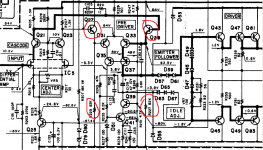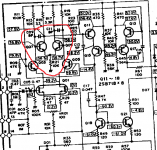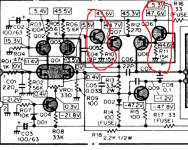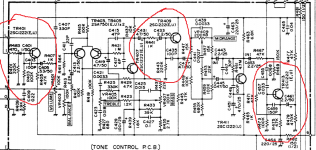Hello. If you want a low impedance output to drive relatively moderate loads like 10K at 15Vpp AC.
EDIT : (The signal is 15Vpp max, but it is lower most of the time. )
(I precised 15Vpp 10K for the loading effect. It can be lower than 1Vpp.)
Is it "better" to use a single transistor source follower, or a op-amp buffer ?
I know that the single transistor will not provide unity gain, but can it be lower noise than an opamp ?
Not all opamp or transistor are the same and there is ones more noisy than other.
But as a general rule. Will the lowest noise transistor be lower noise than the lowest noise opamp ?
Thank you.
EDIT : (The signal is 15Vpp max, but it is lower most of the time. )
(I precised 15Vpp 10K for the loading effect. It can be lower than 1Vpp.)
Is it "better" to use a single transistor source follower, or a op-amp buffer ?
I know that the single transistor will not provide unity gain, but can it be lower noise than an opamp ?
Not all opamp or transistor are the same and there is ones more noisy than other.
But as a general rule. Will the lowest noise transistor be lower noise than the lowest noise opamp ?
Thank you.
Last edited:
Interesting question and it seems that could have many many variables...
Have a read at this:
Emitter Followerl Noise Factor Calculator
Another characteristic of the single transistor is that you will not get DC precision, in other words it is more suited to AC coupled designs. The opamp on the other hand allows DC coupling and true zero volt output offset.
Have a read at this:
Emitter Followerl Noise Factor Calculator
Another characteristic of the single transistor is that you will not get DC precision, in other words it is more suited to AC coupled designs. The opamp on the other hand allows DC coupling and true zero volt output offset.
"better" is a very subjective term.
As a unity gin buffer a fairly simple transistor circuit will do well. I am not sure that I would go right down to a single device (and even less certain that I would settle on nil feedback) but into 10K things are pretty simple.
Then again, an op amp buffer will do very well too. Noise in a unity gain application will be to all sane measures, "damn low".
What are you measuring this by? Parts count, Cost, Distortion, Noise, power consumption... The colour of the bits... all these lead to somewhat varying answers.
In my world, I would choose the op amp. If I had to use discrete, I would not be fussed, but it would not be "first choice"
As a unity gin buffer a fairly simple transistor circuit will do well. I am not sure that I would go right down to a single device (and even less certain that I would settle on nil feedback) but into 10K things are pretty simple.
Then again, an op amp buffer will do very well too. Noise in a unity gain application will be to all sane measures, "damn low".
What are you measuring this by? Parts count, Cost, Distortion, Noise, power consumption... The colour of the bits... all these lead to somewhat varying answers.
In my world, I would choose the op amp. If I had to use discrete, I would not be fussed, but it would not be "first choice"
Thank you. If you had to go for lowest noise ?
I know that transistor are wide in tolerance, while an opamp is pretty much equal unit to unit. More predictable noise figures would be the opamp.
But if you only had to think in term of lowest noise and then lowest distortion, forget about cost, complexity, part count
I know that transistor are wide in tolerance, while an opamp is pretty much equal unit to unit. More predictable noise figures would be the opamp.
But if you only had to think in term of lowest noise and then lowest distortion, forget about cost, complexity, part count
Cannot see noise being an issue at 15vpp with either reasonably low noise opamps or transistors. More like borderline impossible to measure.
As for a single transistor, this implies a coupling capacitor or transformer...
As already mentioned a two transistor circuit, either complementary or SE would work well, but dc stability if output is dc coupled, may be an issue.
As for a single transistor, this implies a coupling capacitor or transformer...
As already mentioned a two transistor circuit, either complementary or SE would work well, but dc stability if output is dc coupled, may be an issue.
Hi Federico, this is a pretty bizarre question.
First, as Analog_SA and JMFahey pointed out, if the signal going through the follower is 15Vpp AC, why are you worrying about noise? A 10nV/rtHz follower circuit with 1MHz BW will result in 10uVRMS or ~14uVpp of noise. This is 120dB SNR, which is really good, more than what you can measure unless you have expensive equipment.
Now, let's say that maybe you made a mistake in stating the problem, the signals are much smaller and noise is an issue. If power is not a constraint, you can achieve the same noise with an op-amp as with the Emitter follower. The op-amp will consume a lot more current though to achieve the same noise level. BUT, the op-amp will offer many benefits like better DC precision, higher input Z, lower output Z, etc.
Other trade-offs are cost and ease of use. An op-amp will cost you more than an EF. Also if the op-amp is an SMT it is more difficult to solder (I myself can solder a SOIC, but anything smaller I cannot do). Finally, you may need extra power supplies if you don't have +/-15V or lower supplies.
I hope this helps.
Best, Sandro
First, as Analog_SA and JMFahey pointed out, if the signal going through the follower is 15Vpp AC, why are you worrying about noise? A 10nV/rtHz follower circuit with 1MHz BW will result in 10uVRMS or ~14uVpp of noise. This is 120dB SNR, which is really good, more than what you can measure unless you have expensive equipment.
Now, let's say that maybe you made a mistake in stating the problem, the signals are much smaller and noise is an issue. If power is not a constraint, you can achieve the same noise with an op-amp as with the Emitter follower. The op-amp will consume a lot more current though to achieve the same noise level. BUT, the op-amp will offer many benefits like better DC precision, higher input Z, lower output Z, etc.
Other trade-offs are cost and ease of use. An op-amp will cost you more than an EF. Also if the op-amp is an SMT it is more difficult to solder (I myself can solder a SOIC, but anything smaller I cannot do). Finally, you may need extra power supplies if you don't have +/-15V or lower supplies.
I hope this helps.
Best, Sandro
Last edited:
Your requirements don't really add up.Thank you.
But just to clarify everything is amplified after this buffer that is why I don't want exessive added noise.
"Everything is amplified" implies substantial gain after the buffer. Like 20, 30 or more dB. But how does that fit with 15 Vpp? Power amplifier output will be 30 Vrms or thereabouts, gain is rarely less than 26 dB (or 20), so input clipping level will be around 1.5 Vrms = 4.2 Vpp.
Yes and no. The opamp would generally have better PSRR, a plain follower rarely makes it beyond about 50 dB. Mind you, it is easy to nullify that advantage if you proceed to use rail decoupling capacitors to pump power supply noise into a highish-impedance shared ground return. Some RC filtering can work wonders.Noise of the buffer will depend more on your power supply and shielding from hum then opamp or transistors used.
A BJT follower will generally have more than low enough input noise due to output driving requirements alone. I would prefer the substantially more linear version with a current source. Beware of one quirk of emitter followers, however - they don't like inductive source impedance and can oscillate. A few hundred ohms of resistance in series with the base should generally tame this.
Sorry guys if you think it's not clear but I stated the 15Vpp into 10K for the ability to supply enough mA to not load the fet. It's the maximum swing I want to achieve. I am not as advanced as you may think, I am just a "forum learner". So again sorry for the unclear questions.
Thank you guys for the suggestions and help, I might go discrete. But I will still build a +/- psu for later if I change my mind and go opamp, unless you tell me that pssr is important (pssr was in my mind yesterday but I forgot to ask about it).
Edit : Signal is AC coupled (RC filter before the buffer) does DC precision still matters ?
Thank you guys for the suggestions and help, I might go discrete. But I will still build a +/- psu for later if I change my mind and go opamp, unless you tell me that pssr is important (pssr was in my mind yesterday but I forgot to ask about it).
Edit : Signal is AC coupled (RC filter before the buffer) does DC precision still matters ?
Last edited:
All these are very high quality audio components...The last one is a full discrete 3 band eq.I have it in realistic STA2250 and there's no audible noise with it.
The second picture is Fisher BA-6000 and it's using a "unity gain" common emitter .Take notes on the compensation needed for higher linearity.
The second picture is Fisher BA-6000 and it's using a "unity gain" common emitter .Take notes on the compensation needed for higher linearity.
Attachments
Last edited:
None of these are standalone emitter followers though, #2 even is another LTP.
I think I saw one in some '70s Braun amp, will have to look when I'm back home. Mid-late '70s is probably the best period to find some. And you'd definitely be looking at the preamp section, not the power amp. With +/-24 V supplies as not uncommon then, even a plain follower with just a resistor can be quite linear. Using high supplies was a common trick in the days when transistors still were expensive.
I think I saw one in some '70s Braun amp, will have to look when I'm back home. Mid-late '70s is probably the best period to find some. And you'd definitely be looking at the preamp section, not the power amp. With +/-24 V supplies as not uncommon then, even a plain follower with just a resistor can be quite linear. Using high supplies was a common trick in the days when transistors still were expensive.
Frederico, current into a 10k resistive load is directly dependent on voltage, not your imagined specification.
For example, if your amplifier has a gain of 20dB and a total output of 30Vrms, it needs 3Vrms or 8.5Vp-p to enter clipping.
We rarely listen to amplifiers at that level in domestic situations, so I'd wager in normal circumstances you would be listening at less than 0.5Vrms out from the 'buffer' stage,
At this level, noise may or may not be an issue. Some of it depends on your speaker sensitivity. Into very sensitive drive units, even fairly low levels of noise become audible.
Take for example a loudspeaker system with 95dB/2.83V sensitivity and a room noise level of 26dB (this is extremely quiet, normally it is closer to 30dB but we'll persist). At close distances, sounds above 27-28dB become audible.
If you have a measured noise of 1.41mV (number chosen for convenient calculation) at amplifier output, it will create speaker output of 32dB (Edit:29dB) , which will be mildly audible at 1m distance, but should blend into the room's noise floor at listening distance (typically 3m).
This is a highly simplified discussion, there are other complications with a high noise floor. For some this level of noise is acceptable at amplifier output, for some it is not.
For example, if your amplifier has a gain of 20dB and a total output of 30Vrms, it needs 3Vrms or 8.5Vp-p to enter clipping.
We rarely listen to amplifiers at that level in domestic situations, so I'd wager in normal circumstances you would be listening at less than 0.5Vrms out from the 'buffer' stage,
At this level, noise may or may not be an issue. Some of it depends on your speaker sensitivity. Into very sensitive drive units, even fairly low levels of noise become audible.
Take for example a loudspeaker system with 95dB/2.83V sensitivity and a room noise level of 26dB (this is extremely quiet, normally it is closer to 30dB but we'll persist). At close distances, sounds above 27-28dB become audible.
If you have a measured noise of 1.41mV (number chosen for convenient calculation) at amplifier output, it will create speaker output of 32dB (Edit:29dB) , which will be mildly audible at 1m distance, but should blend into the room's noise floor at listening distance (typically 3m).
This is a highly simplified discussion, there are other complications with a high noise floor. For some this level of noise is acceptable at amplifier output, for some it is not.
Last edited:
Sorry guys if you think it's not clear but I stated the 15Vpp into 10K for the ability to supply enough mA to not load the fet. It's the maximum swing I want to achieve. I am not as advanced as you may think, I am just a "forum learner". So again sorry for the unclear questions.
Thank you guys for the suggestions and help, I might go discrete. But I will still build a +/- psu for later if I change my mind and go opamp, unless you tell me that pssr is important (pssr was in my mind yesterday but I forgot to ask about it).
It seems to me you are fairly new to the art of amplifier design. I am actually putting a small course on Youtube (my fun side project) where I try to teach new guys about amp design and also designing what I hoping will be the lowest distortion amp around (I aiming high here ). I am a bit behind because I am travelling, butt will get back to it soon. Here are some links:
SW-VFA-01: Audio power amplifier video series
SW-VFA-01: Audio power amplifier video series
Let me know what you think.
- Status
- This old topic is closed. If you want to reopen this topic, contact a moderator using the "Report Post" button.
- Home
- Source & Line
- Analog Line Level
- Opamp vs single transistor buffer



